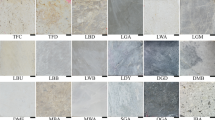Abstract
This research is focused on the study and comparison of different methods to select the most suitable non-destructive hardness-measuring equipment capable of assessing the hardness of analog planetary rocks in space environments. Proceq’s Equotip 3 equipment proved to be the most suitable alternative, and it was possible to carry out, for the first time, a microgravity experiment inside a Falcon 20 aircraft during parabolic flight. Studying the rebound principle and recognizing that this value is affected by the variation in gravity, it was essential to propose compensation values to correct it, based on previous works regarding impact direction change. This study addresses the preliminary results of ongoing research in the area of rock hardness detection.
Access this chapter
Tax calculation will be finalised at checkout
Purchases are for personal use only
Similar content being viewed by others
References
Bailey NG, Ulrich GE (1975) Apollo 17 voice transcript pertaining to the geology of the landing site. U.S. Geological Survey, Branch of Astrogeology Flagstaff, Arizona
Bezy JV (2003) A guide to the geology of the Flagstaff area. Arizona Geological Survey, Tucson
Frank S, Frehner C, Akhlaghi A (2019) Equotip application booklet: portable hardness testing – Leeb, Portable Rockwell and UCI. Proceq SA, Switzerland
ISRM – International Society for Rock Mechanics (2007) The complete ISRM suggested methods for characterization, testing and monitoring: 1974–2006. In: R Ulusay, JA Hudson (eds.) Suggested Methods Prepared by the Commission on Testing Methods, ISRM, Ankara
ISO 16859 (2015) Metallic materials — Leeb hardness test — Part 1: Test method; Part 2: Verification and calibration of the testing devices; Part 3: Calibration of reference test blocks (www.iso.org)
ISRM – International Society for Rock Mechanics (2015) The ISRM suggested methods for rock characterization, testing and monitoring: 2007–2014. In: R Ulusay (ed.) Suggested Methods Prepared by the Commission on Testing Methods, ISRM, Springer, Berlin
ISRM – International Society for Rock Mechanics (1980) Rock characterization, testing and monitoring: ISRM suggested methods. In: ET Brown (ed.) suggested methods prepared by the Commission on Testing Methods, ISRM, Pergamon Press, Abstracts 15(6), 319–368
Kılıç A, Teymen A (2008) Determination of mechanical properties of rocks using simple methods. Bull Eng Geol Environ 67:237–244
Moura R, Almeida F, Persad A, Ferreira A, Teixeira L, Gowanlock D, Sant’Ovaia H, Reimuller J (2019) Preliminary results of compressional seismic wave velocity measurements of lunar regolith simulant (JSC-1) during a microgravity flight campaign. In: Proceedings of the 19th International Multidisciplinary Scientific GeoConference, SGEM, Albena, Bulgaria
Moura R, Almeida F, Ferreira A, Persad A, Teixeira L, Gowanlock D, Sant’Ovaia H, Reimuller J, Parkhill M, Pires A (2020) Microgravity geophysical experiments with JSC-1 lunar regolith simulant: results and future developments within project PoSSUM. In: Proceedings of the Next-Generation Suborbital Researchers Conference, Broomfield, Colorado
NASA (1973) Apollo 17: preliminary science report. National Aeronautics and Space Administration, NASA-SP 330, Washington DC [https://www.hq.nasa.gov/alsj/a17/as17psr.pdf9] (last accessed October 2020)
Parker AH, Walsh KJ, Durda DD, Nowicki K, Project ESPRESSO Team (2019) Magnetic grapples for asteroid regolith sample collection, anchoring, and mobility. In: 50th Lunar and Planetary Science Conference 2019 (LPIContrib.No.2132) [https://www.hou.usra.edu/meetings/lpsc2019/pdf/3111.pdf] (last accessed December 2020)
Pérez-Alberti A, Gomes A, Trenhaile AS, Oliveira M, Horacio J (2013) Correlating river terrace remnants using an Equotip hardness tester: an example from the Miño River, northwestern Iberian Peninsula. Geomorphology 192:59–70
Pires A, Chaminé HI, Pérez-Alberti A, Gomes A, Rocha F (2014a) Rock strength assessment and structural features analysis on rocky coasts. In: LR Alejano, A Perucho, C Olalla, R Jiménez (Eds.) Proceedings of the Eurock’2014, Rock Engineering and Rock Mechanics: Structures in and on Rock Masses (ISRM European Regional Symposium, Vigo, Spain), CRC Press/Balkema, Taylor & Francis Group, London, pp. 1267–1272
Pires A, Chaminé HI, Piqueiro F, Rocha F (2014b) Coastal geo-engineering techniques for the assessment of rock armour structures. Mar Georesour Geotech 32(2):155–217
Poole RW, Farmer IW (1980) Consistency and repeatability of Schmidt hammer rebound data during field testing. Int J Rock Mech Min Sci Geomech Abst 17:167–171
Proceq (1985) Equotip hardness tester: conversion tables, impact device D. Proceq SA, Switzerland
Schmidt E (1951) A non-destructive concrete tester. Concrete 59(8):34–35
Siddiqi AA (2000) Challenge to Apollo: The Soviet Union and the space race 1945–1974. NASA History Series SP-2000-4408, Washington DC
Viles H, Goudie A, Grab S, Lalley J (2011) The use of Schmidt Hammer and Equotip for rock hardness assessment in geomorphology and heritage science: a comparative analysis. Eart Surf Proc Land 36(3):320–333
Acknowledgements
Our thanks are due to the National Research Council (NRC) of Canada for providing all the safety requirements during the flight campaign and all the land support. Special thanks are also due to Dariusz Burnat (Proceq), Sonia Girón, and Marcel Poser (Screening Eagle Technologies) for all the support concerning Equotip’s equipment. AP was partially sponsored by Luso-American Development Foundation (FLAD). The investigation was funded by a research contract under the Portuguese Foundation for Science and Technology, FCT (CEECIND/00835/2018) to AP and supported within project UIDB/50014/2020. HIC was supported under the framework of the LABCARGA|ISEP re-equipment program (IPP-ISEP|PAD’2007/08) and Centre GeoBioTec|UA (FCT–UID/GEO/04035/2020). In addition, APA received support from CRETUS—AMBISOL|USC (Spain). Finally, we acknowledge the anonymous reviewers for the constructive comments that helped to improve the manuscript.
Author information
Authors and Affiliations
Corresponding author
Editor information
Editors and Affiliations
Rights and permissions
Copyright information
© 2023 The Author(s), under exclusive license to Springer Nature Switzerland AG
About this paper
Cite this paper
Pires, A. et al. (2023). Hardness Tester for Analog Planetary Rocks: A Preliminary Assessment in Microgravity Flight. In: Chaminé, H.I., Fernandes, J.A. (eds) Advances in Geoengineering, Geotechnologies, and Geoenvironment for Earth Systems and Sustainable Georesources Management. Advances in Science, Technology & Innovation. Springer, Cham. https://doi.org/10.1007/978-3-031-25986-9_35
Download citation
DOI: https://doi.org/10.1007/978-3-031-25986-9_35
Published:
Publisher Name: Springer, Cham
Print ISBN: 978-3-031-25985-2
Online ISBN: 978-3-031-25986-9
eBook Packages: Earth and Environmental ScienceEarth and Environmental Science (R0)




